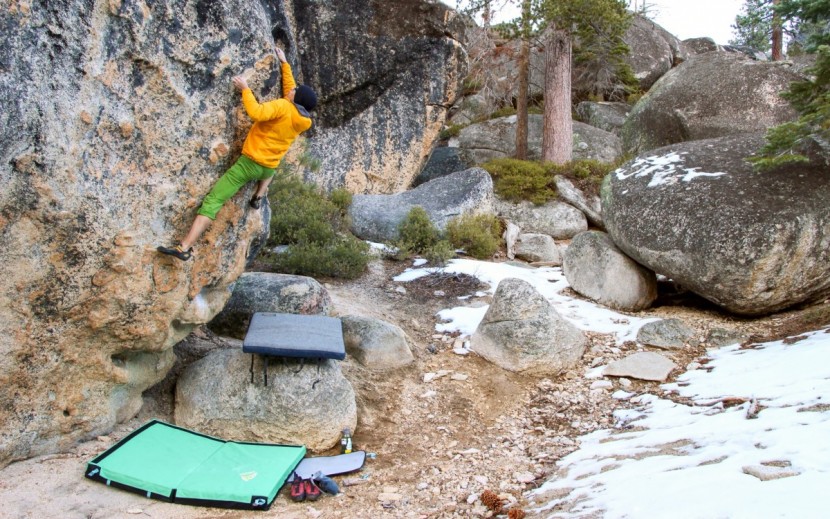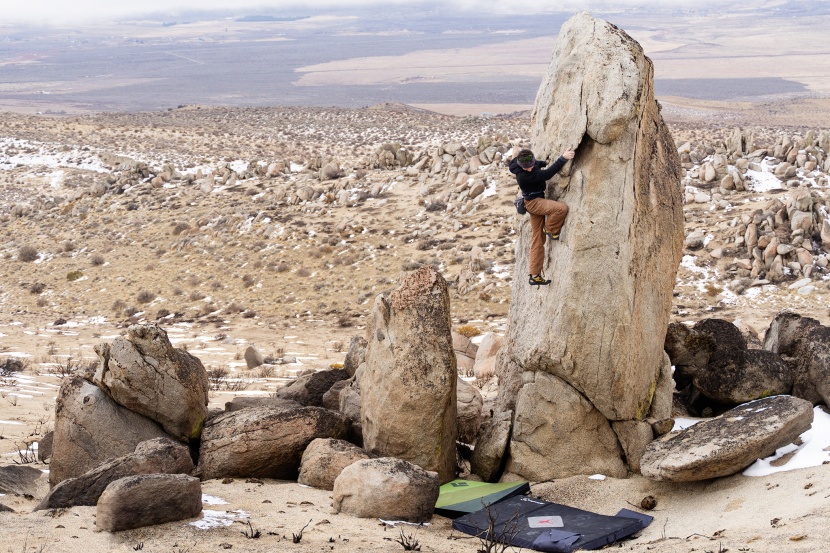Our testers used these crash pads on a variety of boulder problems. We climbed small problems and tall scary boulder problems and took the fall. We did it all in the name of testing and not because we couldn't hold on, of course. We climbed over perfectly flat landings as well as rocky and root-filled landings. We hiked these crash pads fully loaded long distances to backcountry boulders. Our testers ranged from big to small and from first-time climbers to lifers.
Padding Falls
High Falls
This metric is arguably the most important. While bouldering high above the ground, it is difficult to quiet the mind and focus on the climbing. It becomes easier to climb up high if you know that if you fall, your crash pads will allow for a fall that won't leave you crippled. This metric was tested by falling off of Tahoe's tall boulder problems. When falling from up high, we note the padding, the pad's ability to mitigate rocks and talus, its hinge design, and other considerations.
Low Falls
Evaluating a crash pad's low fall performance is important because climbers take constant and repetitive low falls. We tested this by taking the pads out bouldering and intentionally falling within a few moves on a problem. We also jumped from step ladders onto the pad to repeatedly get results and to gain an impression. Specific performance factors included the pad's padding feel and ability to mitigate rocks and talus while falling low.
Durability
Evaluating a crash pad's durability is crucial, as bouldering is very hard on equipment. Unfortunately, due to the nature of a testing period that spans months, not years, it is difficult to tell how easily the foam “packed out.” We have a lot of bouldering experience among our testers and many years of experience falling on these pads to reinforce our durability assessments. We also noted if the seams, straps, and fabric used began to show signs of wear. We noted when a crash pad was made with less than suitable materials. Luckily for the modern boulderer, today's crash pads are almost all made with high durability in mind.
Packing Gear
Evaluating a crash pad's ability to pack gear is less important than its performance during falls or durability. That being said, a pad's ability to carry your stuff will make you grab it first from the stack since it's never fun to walk with a mattress on your back and not have your hands free. The crash pad's ability to pack gear was noted while using them during testing. The pads with features that aid in carrying equipment scored highly, whereas the pads with limited features or that require stuffing gear inside them, making them uncomfortable or difficult to use, scored poorly.
Features
Evaluating a crash pad's features is also less important than its performance during falls or durability. However, when a pad has features you like, it will be the first one you grab from the pile of pads when going bouldering. Crash pads with features such as a place to wipe your shoes carry additional pads, and other features scored highly in this category. Pads that lack features that make them less functional for a day of bouldering scored poorly in this category.






